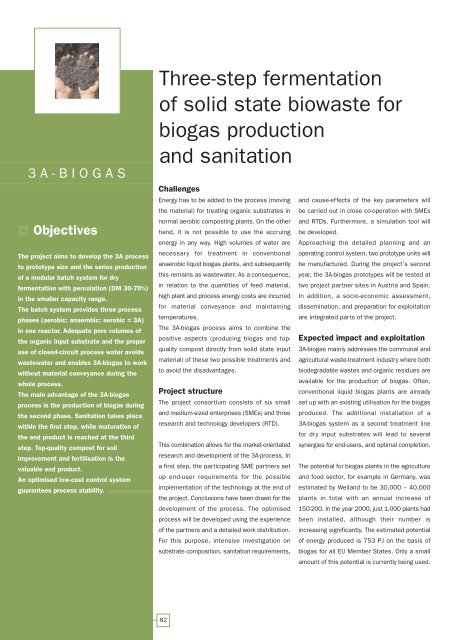European Bio-Energy Projects
European Bio-Energy Projects
European Bio-Energy Projects
You also want an ePaper? Increase the reach of your titles
YUMPU automatically turns print PDFs into web optimized ePapers that Google loves.
3A-BIOGAS<br />
Objectives<br />
The project aims to develop the 3A process<br />
to prototype size and the series production<br />
of a modular batch system for dry<br />
fermentation with percolation (DM 30-70%)<br />
in the smaller capacity range.<br />
The batch system provides three process<br />
phases (aerobic; anaerobic; aerobic = 3A)<br />
in one reactor. Adequate pore volumes of<br />
the organic input substrate and the proper<br />
use of closed-circuit process water avoids<br />
wastewater and enables 3A-biogas to work<br />
without material conveyance during the<br />
whole process.<br />
The main advantage of the 3A-biogas<br />
process is the production of biogas during<br />
the second phase. Sanitation takes place<br />
within the first step, while maturation of<br />
the end product is reached at the third<br />
step. Top-quality compost for soil<br />
improvement and fertilisation is the<br />
valuable end product.<br />
An optimised low-cost control system<br />
guarantees process stability.<br />
Three-step fermentation<br />
of solid state biowaste for<br />
biogas production<br />
and sanitation<br />
Challenges<br />
<strong>Energy</strong> has to be added to the process (moving<br />
the material) for treating organic substrates in<br />
normal aerobic composting plants. On the other<br />
hand, it is not possible to use the accruing<br />
energy in any way. High volumes of water are<br />
necessary for treatment in conventional<br />
anaerobic liquid biogas plants, and subsequently<br />
this remains as wastewater. As a consequence,<br />
in relation to the quantities of feed material,<br />
high plant and process energy costs are incurred<br />
for material conveyance and maintaining<br />
temperatures.<br />
The 3A-biogas process aims to combine the<br />
positive aspects (producing biogas and topquality<br />
compost directly from solid state input<br />
material) of these two possible treatments and<br />
to avoid the disadvantages.<br />
Project structure<br />
The project consortium consists of six small<br />
and medium-sized enterprises (SMEs) and three<br />
research and technology developers (RTD).<br />
This combination allows for the market-orientated<br />
research and development of the 3A-process. In<br />
a first step, the participating SME partners set<br />
up end-user requirements for the possible<br />
implementation of the technology at the end of<br />
the project. Conclusions have been drawn for the<br />
development of the process. The optimised<br />
process will be developed using the experience<br />
of the partners and a detailed work distribution.<br />
For this purpose, intensive investigation on<br />
substrate composition, sanitation requirements,<br />
82<br />
and cause-effects of the key parameters will<br />
be carried out in close co-operation with SMEs<br />
and RTDs. Furthermore, a simulation tool will<br />
be developed.<br />
Approaching the detailed planning and an<br />
operating control system, two prototype units will<br />
be manufactured. During the project’s second<br />
year, the 3A-biogas prototypes will be tested at<br />
two project partner sites in Austria and Spain.<br />
In addition, a socio-economic assessment,<br />
dissemination, and preparation for exploitation<br />
are integrated parts of the project.<br />
Expected impact and exploitation<br />
3A-biogas mainly addresses the communal and<br />
agricultural waste-treatment industry where both<br />
biodegradable wastes and organic residues are<br />
available for the production of biogas. Often,<br />
conventional liquid biogas plants are already<br />
set up with an existing utilisation for the biogas<br />
produced. The additional installation of a<br />
3A-biogas system as a second treatment line<br />
for dry input substrates will lead to several<br />
synergies for end-users, and optimal completion.<br />
The potential for biogas plants in the agriculture<br />
and food sector, for example in Germany, was<br />
estimated by Weiland to be 30,000 – 40,000<br />
plants in total with an annual increase of<br />
150-200. In the year 2000, just 1,000 plants had<br />
been installed, although their number is<br />
increasing significantly. The estimated potential<br />
of energy produced is 753 PJ on the basis of<br />
biogas for all EU Member States. Only a small<br />
amount of this potential is currently being used.

















